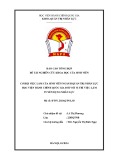
This Provisional PDF corresponds to the article as it appeared upon acceptance. Fully formatted
PDF and full text (HTML) versions will be made available soon.
On quotients and differences of hypergeometric functions
Journal of Inequalities and Applications 2011, 2011:141 doi:10.1186/1029-242X-2011-141
Slavko Simic (ssimic@turing.mi.sanu.ac.rs)
Matti Vuorinen (vuorinen@utu.fi)
ISSN 1029-242X
Article type Research
Submission date 15 July 2011
Acceptance date 21 December 2011
Publication date 21 December 2011
Article URL http://www.journalofinequalitiesandapplications.com/content/2011/1/141
This peer-reviewed article was published immediately upon acceptance. It can be downloaded,
printed and distributed freely for any purposes (see copyright notice below).
For information about publishing your research in Journal of Inequalities and Applications go to
http://www.journalofinequalitiesandapplications.com/authors/instructions/
For information about other SpringerOpen publications go to
http://www.springeropen.com
Journal of Inequalities and
Applications
© 2011 Simic and Vuorinen ; licensee Springer.
This is an open access article distributed under the terms of the Creative Commons Attribution License (http://creativecommons.org/licenses/by/2.0),
which permits unrestricted use, distribution, and reproduction in any medium, provided the original work is properly cited.

On quotients and differences of hypergeometric functions
Slavko Simi´c∗1and Matti Vuorinen2
1Mathematical Institute SANU, Kneza Mihaila 36, 11000 Belgrade, Serbia
2Department of Mathematics, University of Turku, 20014 Turku, Finland
*Corresponding author: ssimic@turing.mi.sanu.ac.rs
Email address:
MV: vuorinen@utu.fi
Abstract For Gaussian hypergeometric functions F(x) = F(a, b;c;x), a, b, c > 0,we
consider the quotient QF(x, y) = (F(x) + F(y))/F (z) and the difference DF(x, y) =
F(x) + F(y)−F(z) for 0 < x, y < 1 with z=x+y−xy. We give best possible bounds
for both expressions under various hypotheses about the parameter triple (a, b;c).
2010 Mathematics Subject Classification: 26D06; 33C05.
Keywords: sub-additivity; hypergeometric functions; inequalities.
1. Introduction
Among special functions, the hypergeometric function has perhaps the widest range
of applications. For instance, several well-known classes of special functions such as
complete elliptic integrals, Legendre functions, Chebyshev and Jacobi polynomials, and
some elementary functions, such as the logarithm, are particular cases of it, cf. [1]. In
a recent article [2] the authors studied various extensions of the Bernoulli inequality for
functions of logarithmic type. In particular, the zero-balanced hypergeometric function
F(a, b;a+b;x), a, b > 0 occurs in these studies, because it has a logarithmic singularity
at x= 1,see (2.8) below. We now continue the discussion of some of the questions for
quotients and differences of hypergeometric functions that were left open in [2].
1

2
Motivated by the asymptotic behavior of the function F(x) = F(a, b;c;x) when x→1−,
see (2.8), we define for 0 < x, y < 1, a, b, c > 0
(1.1) QF(x, y) := F(x) + F(y)
F(x+y−xy), DF(x, y) := F(x) + F(y)−F(x+y−xy).
Our task in this article is to give tight bounds for these quotients and differences
assuming various relationships between the parameters a, b, c.
For the general case, we can formulate the following theorem.
Theorem 1.2. For a, b, c > 0and 0< x, y < 1let QFbe as in (1.1). Then,
(1.3) 0 < QF(x, y)≤2.
The bounds in (1.3) are best possible as can be seen by taking [1, 15.1.8]
F(x) = F(a, b;b;x) = (1 −x)−a:= F0(x).
Then,
QF0(x, y) = (1 −x)−a+ (1 −y)−a
(1 −x−y+xy)−a=(1 −x)−a+ (1 −y)−a
((1 −x)(1 −y))−a= (1 −x)a+ (1 −y)a,
and the conclusion follows immediately. Similarly,
Theorem 1.4. For a, b > 0, c > a +band 0< x, y < 1, we have
(1.5) |DF(x, y)| ≤ A,
with A=A(a, b, c) = Γ(c)Γ(c−a−b)
Γ(c−a)Γ(c−b)=F(a, b;c; 1) as the best possible constant.
Most intriguing is the zero-balanced case. For example,

3
Theorem 1.6. For a, b > 0and 0< x, y < 1let DFbe as in (1.1). Then,
(1.7) R
B< DF(x, y)<1
with R=R(a, b) = −2γ−ψ(a)−ψ(b), B =B(a, b).
Both bounding constants are best possible.
In the sequel, we shall give a complete answer to an open question posed in [2].
2. Preliminary results
In this section, we recall some well-known properties of the Gaussian hypergeometric
function F(a, b;c;x) and certain of its combinations with other functions, for further
applications.
It is well known that hypergeometric functions are closely related to the classical gamma
function Γ(x), the psi function ψ(x), and the beta function B(x, y). For Re x > 0,Re y > 0,
these functions are defined by
(2.1) Γ(x)≡
∞
Z
0
e−ttx−1dt, ψ(x)≡Γ′(x)
Γ(x), B(x, y)≡Γ(x)Γ(y)
Γ(x+y),
respectively (cf. [1, Chap. 6]). It is well known that the gamma function satisfies the
difference equation [1, 6.1.15]
(2.2) Γ(x+ 1) = xΓ(x),
and the reflection property [1, 6.1.17]
(2.3) Γ(x)Γ(1 −x) = π
sin πx =B(x, 1−x).

4
We shall also need the function
(2.4) R(a, b)≡−2γ−ψ(a)−ψ(b), R(a)≡R(a, 1−a), R µ1
2¶=log 16,
where γis the Euler-Mascheroni constant given by
(2.5) γ= lim
n→∞µn
X
k=1
1
k−log n¶= 0.577215 . . . .
Given complex numbers a, b, and cwith c6= 0,−1,−2, . . ., the Gaussian hypergeometric
function is the analytic continuation to the slit plane C\[1,∞) of the series
(2.6) F(a, b;c;z) = 2F1(a, b;c;z) = ∞
X
n=0
(a, n)(b, n)
(c, n)
zn
n!,|z|<1.
Here (a, 0) = 1 for a6= 0, and (a, n) is the shifted factorial function or the Appell symbol
(a, n) = a(a+ 1)(a+ 2) ···(a+n−1)
for n∈N\ {0}, where N={0,1,2, . . .}.
The hypergeometric function has the following simple differentiation formula ([1, 15.2.1])
(2.7) d
dxF(a, b;c;x) = ab
cF(a+ 1, b + 1; c+ 1; x).
An important tool for our study is the following classification of the behavior of the
hypergeometric function near x= 1 in the three cases a+b < c, a +b=c, and a+b > c :
(2.8)
F(a, b;c; 1) = Γ(c)Γ(c−a−b)
Γ(c−a)Γ(c−b), a +b < c,
B(a, b)F(a, b;a+b;x)+log(1−x) =R(a, b)+O((1−x) log(1−x)),
F(a, b;c;x) = (1−x)c−a−bF(c−a, c−b;c;x), c < a+b.
Some basic properties of this series may be found in standard handbooks, see for ex-
ample [1]. For some rational triples (a, b, c), the functions F(a, b;c;x) can be expressed



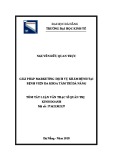
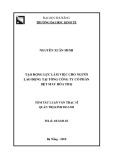
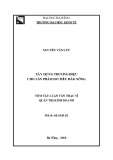
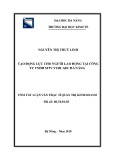

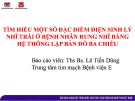
![Hình ảnh học bệnh não mạch máu nhỏ: Báo cáo [Năm]](https://cdn.tailieu.vn/images/document/thumbnail/2024/20240705/sanhobien01/135x160/1985290001.jpg)
